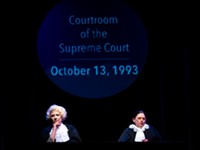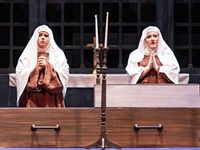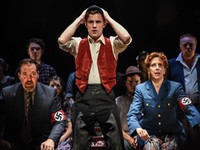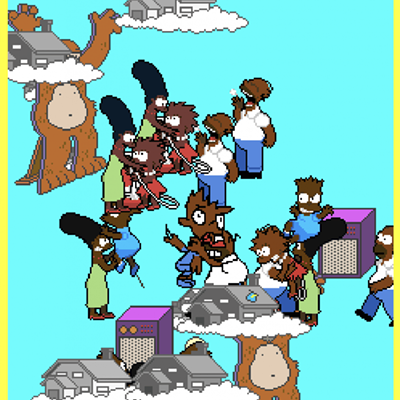[
{
"name": "500x250 Ad",
"insertPoint": "5",
"component": "15667920",
"parentWrapperClass": "",
"requiredCountToDisplay": "1"
}
]
The concept could not be simpler: women talking about clothes. Except they're not really talking about clothes. The items in question — that first training bra, a heinous birthday-gift outfit, the robe worn by a dearly departed mother — are merely touchstones, relatable details to draw the audience into the personal stories of everyday people.
And that's what makes "Love, Loss, and What I Wore" so surprisingly powerful. Because the premise is so accessible, and the staging so laid back (five women in chairs, occasionally glancing at scripts on the music stands in front of them), these brief stories about life's big and little moments feel honest, truthful, and most of all, intimate. Women in particular will identify with the content of these vignettes, which run the gamut from the heartbreaking to the hilarious. But the simplicity and honesty of the material means that anyone, even if they're cursed with a Y chromosome, will be transfixed. This is not a show about clothes. It's a show about life.
"Love, Loss, and What I Wore" started its life as a book by Ilene Beckerman. In it, Beckerman included her drawings of clothing items that made an impact in her life, and her recollections about the defining moments in which she wore them (marriages, divorces, deaths, births, etc.). Noted screenwriter Nora Ephron ("Silkwood," "When Harry Met Sally...") wrote an introduction for the book, and later, Ephron and her producer-writer sister, Delia, decided to adapt it for the stage. The Ephrons incorporated several of Beckerman's stories (the character of Gingy, who serves as a sort of narrator in the play, is pretty obviously based on Beckerman), as well as some of the sisters' own critically acclaimed short pieces. They also reached out to dozens of female friends, asking them to share similar stories.
Thus, the stage version of the book actually features the stories of dozens of women. So it's fitting that the cast is similarly varied, with eight local actresses — Ruth Bellavia, Maureen Brainard, Marlo DiCrasto, McKenzie Keenan, Patti Lewis, Lee Ann Orasin, Sarah Peters, and Maria Scipione — rotating through five spots. The night I saw the show, Kennan played Gingy — the only character with a name in the show — and Lewis, Bellavia, DiCrasto, and Orasin filled out the cast. The swapping of roles from show to show makes the on-stage scripts understandable (and honestly, the cast I saw just glanced at them), and allows for any number of combinations of actresses and stories. Even Director John Haldoupis admitted that he hasn't seen every iteration of the cast yet.
The five actors in the performance I saw did an excellent job, seamlessly passing along the narrative (the only awkward moment was the fault of a clunky audio cue in the Madonna section) and connecting with the emotional content of the show's numerous monologues.
Keenan was especially effective as Gingy, giving a wistful yet dignified portrayal flecked by a Long Island accent. DiCrasto was equally at home delivering a powerful story about a cancer survivor and a sweet vignette about an unconventional woman searching for the perfect wedding outfit. Orasin hilariously detailed the debate between painful-but-fashionable high heels and comfy-but-hideous Birkenstocks, although she was less successful in an odd segment about gang sweaters. Several people in the audience responded audibly to Bellavia's story about two prom dresses, and the personal revelation that closes that story.
But that was nothing compared to the reaction of Lewis's show-stopping diatribe about purses (a piece that was signature Ephron, from start to finish). As soon as the commanding Lewis stood, moved her music stand to the center of the stage, and said something along the lines of, "I'd like to say something about purses," the dynamic of the audience shifted. I heard several women responding to line after line of the fashion sermon with hushed affirmations. It was like being in church, truly. As Lewis railed about the detritus of life accumulating in the bottom of a bag, one woman behind me whispered, "Yep, that's me." As Lewis complained about how it takes hours to find anything in her purse, the same woman replied, "Amen." And when Lewis made the statement that, on some horrific level, those messy, cumbersome purses are a reflection of the lives of the women who wield them, I could almost feel the stunned silence from the seat behind me.
The threshold of revelation, from a story about a purse.
Latest in Theater
More by Eric Rezsnyak
-
“Doctor Who” Series 8: “Into the Dalek”/“Robot of Sherwood”
Sep 7, 2014 -

“True Blood” Series Finale: “Thank You”
Aug 24, 2014 -
“Doctor Who” Series 8, Episode 1: “Deep Breath”
Aug 24, 2014 - More »





